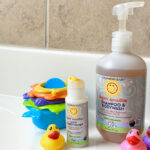Baby talk
Written by: Josh April 27 2011 One of the lesser-known […]
One of the lesser-known benefits of parenting is the lexical growth and transformation your vocabulary will take on.
Here is an old-school matching exercise, filled with words I personally have Rosetta-Stoned in the last few months (answers at the end of the post):
1. Colostrum
2. Bassinet
3. Colic
4. Swaddle
5. Tummy time
6. Baby carrier
7. Moro reflex
8. Onesie
9. Mastitis
10. Cradle cap
a. a sleeping unit that precedes the crib
b. an article that goes over the head and ingeniously snaps at the crotch
c. an innate response to a falling or loud noises
d. dry, reptilian-esque skin on top of Baby’s head
e. a device for transporting your sprout, worn on your chest
f. yellow liquid that comes down before breast milk (aka liquid gold)
g. semi-torturous exercise ostensibly aimed at strengthening the neck
h. to wrap Baby up snug as the proverbial bug in the rug
i. a noise that can’t be described, only experienced
j. painful blockage in breasts that prevents milk from coming down
But it’s not so much the new words that I find so interesting as the way we choose our words with babies. And I’m not referring to the goo-gooing gibberish we call “engaging” Baby, I’m talking about actual words that are manipulated in various ways by the medical field, but seem to serve unknown purposes. Consider the following examples:
Feed: Your baby does not eat, according the experts. No, like some kind of genetically-altered creature in a straight-to-DVD horror flick, he feeds. Four teenagers just wanted to get away for spring break. They didn’t know it was … Feeding Time. Dun dun dun.
And Baby doesn’t have meals, he has feedings. How many feedings does your baby have a day? It’s just weird. What is he, a python at the Reptile Pavilion? As the bottle gets dangerously near the apparently-slumbering creature, the baby’s tongue suddenly shoots out, injecting the bottle with paralyzing toxins. Baby then slowly devours the bottle from the inside out, leaving nothing but a BPA-free shell behind. Ironic, considering he has no teeth. Which brings me to number two …
Eat: That child is not actually eating. Trust me, I’ve seen eating, and that’s not it. Eating involves placing desired food item into mouth followed by a healthy dose of mastication, followed by swallowing and digestion. To call that eating is like calling Kim Kardashian a celebrity. No, there’s liquid in that bottle (or breast) and Baby ingests said liquid. It’s called drinking. These are first-grade verbs, people, and I don’t know why they get skewed just because a baby is performing them. Let’s call a spade a spade—your child is a heavy drinker.
Long: Another interesting choice of labeling. Baby is measured in length, not height. Like a dinghy or a line at the supermarket, how long is he? Where’s the logic in this? I get that Baby is mostly prone these days, but surely he will one day stand erectus maximus. Then you’re just confusing him. And at what point, exactly, does he become x inches tall? Why start measuring in length at all if you’re just going to abandon it? Being the natural rabble-rouser I am, I have started my subversion campaign to challenge everything. So Baby is officially 24 inches tall and I’m 72 inches long, in case you were wondering. Oh, and Baby’s not thirsty, because he just got done drinking. Take that, pediatricians.
Answer key: 1. f, 2. a, 3. i, 4. h, 5. g, 6. e, 7. c, 8. b, 9. j, 10. d







